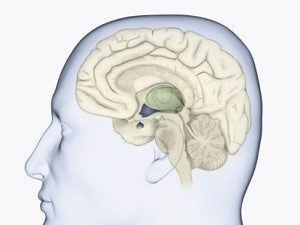Hypothalamus
 The hypothalamus is a small but important structure in the center of the brain. It has two main purposes. The first is to regulate the autonomic nervous system. The second purpose is to work with the pituitary gland to control the endocrine system and release hormones into the blood stream.
The hypothalamus is a small but important structure in the center of the brain. It has two main purposes. The first is to regulate the autonomic nervous system. The second purpose is to work with the pituitary gland to control the endocrine system and release hormones into the blood stream.
Functions of the Hypothalamus
Despite its small size, the hypothalamus performs a diverse array of functions, including:
- Maintaining homeostasis—the relatively consistent maintenance of internal functions. It does this by monitoring temperature, heart rate, blood pressure, and other vital functions.
- Reacting to conditions that threaten homeostasis. For example, if our blood sugar level drops, the hypothalamus may send hunger hormones into our bloodstream to tell us to eat. Our bodies digest the food, and our blood sugar levels return to a set baseline. The hypothalamus is also responsible for shivering, sweating, and feelings of thirst.
- Helping regulate our sleep-wake cycle and daily cycles—also known as circadian rhythm. The hypothalamus is highly sensitive to light. When a person does not experience typical cycles of daylight (such as when they work the night shift), their sleep may be disturbed.
- Releasing hormones related to childbirth and breastfeeding. Perhaps the most famous of these is oxytocin, which controls the release of breast milk and helps parents bond with their children.
- Contributing to puberty and sexual differentiation. It tells the pituitary gland when to release growth hormones and sex hormones into the body. This helps children develop into adults and become fertile.
- The hypothalamus also influences our sex drive by monitoring the level of sex hormones in the body. If a person does not have enough sex hormones in the body, they may lose desire for intimacy. On the other hand, too many sex hormones may lead to an unhealthy obsession with or dependence on sex.
Structure and Location of the Hypothalamus
Located above the brain stem and just below the thalamus, the hypothalamus is about the size of a fingernail. The pituitary gland is attached to the base of the hypothalamus and links the endocrine system to the nervous system.
The hypothalamus is divided into three regions: anterior (front), tuberal (middle), and posterior (back). Each region contains several nuclei—clusters of neurons that perform related functions. For example, the tuberal region contains three nuclei which each control a different aspect of eating and digestion.
The hypothalamus has 11 principle nuclei:
- Dorsomedial nucleus: Regulates our urge to eat.
- Ventromedial nucleus: Tells us when our stomachs are full.
- Lateral nucleus: Controls our metabolism.
- Preoptic nucleus: Tells the pituitary gland to release more hormones that keep our sex organs functional.
- Supraoptic nucleus: Helps with childbirth and breastfeeding by releasing oxytocin.
- Arcuate nucleus: Tells the body to stop releasing milk for breastfeeding.
- Paraventricular nuclei: Controls fluid levels by producing antidiuretic hormone.
- Anterior nucleus: Stimulates parasympathetic nervous system to cool the body.
- Posterior nucleus: Stimulates sympathetic nervous system to warm the body.
- Suprachiasmatic nucleus: Regulates the body’s circadian rhythm.
- Mammillary nucleus: Contributes to short-term memory and emotion.
It’s important to note that the above list is a generalization. Nuclei work closely together, so their functions can overlap.
Hypothalamus and Mental Health Issues
The hypothalamus controls many of our bodily rhythms. But if certain hormones are released at the wrong time, they can create a domino effect in our lives. For example, if melatonin is released at the wrong time, we can have trouble falling asleep. A poor night’s sleep can make us feel groggy and irritable. The stress can lead to muscle tension, and the pain in turn can make it hard to relax at night.
If a hypothalamus malfunctions consistently, it can contribute to mental health conditions. Research has linked hypothalamus dysfunction to:
When a person’s mental health issues are caused by a malfunctioning hypothalamus, they will likely need medical care in addition to therapy.
References:
- Dougherty, P. (n.d.). Hypothalamus: Structural organization. Retrieved from https://nba.uth.tmc.edu/neuroscience/m/s4/chapter01.html
- (n.d.). Retrieved from https://www.kenhub.com/en/library/anatomy/hypothalamus
- Murrell, D. (2018, August 22). What does the hypothalamus do? Medical News Today. Retrieved from https://www.medicalnewstoday.com/articles/312628.php
- Overeem, S., van Vliet, J., Lammers, G. J., Zitman, F. G., Swaab, D. F., & Ferrari, M. D. (2002). The hypothalamus in episodic brain disorders. The Lancet, 1(7), 435-444. Retrieved from https://www.thelancet.com/journals/laneur/article/PIIS1474442202001916/fulltext
Last Updated: 11-8-2019
- 2 comments
- Leave a Comment
Michelle Woods
October 8th, 2018 at 6:30 PMThank you for your site.
jan
July 29th, 2021 at 9:26 PMthank you for this site wants to make my hypothalamus and pituitary gland healthy
Leave a Comment
By commenting you acknowledge acceptance of GoodTherapy.org's Terms and Conditions of Use.

